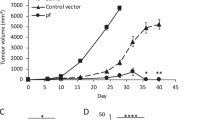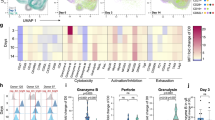Abstract
The FGFs constitute a family of, at least, 12 polypeptides (FGF1 to FGF12) implicated in a number of physiological and pathological processes throughout embryogenesis and adult life. They bind to at least three types of cell surface molecules, including four high affinity transmembrane tyrosine kinase receptors (FGFR1 to FGFR4). In addition to important roles during development, FGF involvement in pathological conditions, including tumour formation, has been suspected, and overexpression of FGFR in tumour specimens is well documented. Diphtheria Toxin/FGF6 (DT/FGF6) mitotoxin has been shown to selectively and effectively target FGFR1-expressing cells. We show here that DT/FGF6 targets myoblasts engineered to express either one of the four FGFR, as well as FGFR-expressing tumour cells.
This is a preview of subscription content, access via your institution
Access options
Subscribe to this journal
Receive 50 print issues and online access
$259.00 per year
only $5.18 per issue
Buy this article
- Purchase on Springer Link
- Instant access to full article PDF
Prices may be subject to local taxes which are calculated during checkout
Similar content being viewed by others
Author information
Authors and Affiliations
Rights and permissions
About this article
Cite this article
Coll-Fresno, P., Batoz, M., Tarquin, S. et al. Cytotoxic activity of a diphtheria toxin/FGF6 mitotoxin on human tumour cell lines. Oncogene 14, 243–247 (1997). https://doi.org/10.1038/sj.onc.1200826
Received:
Revised:
Accepted:
Issue Date:
DOI: https://doi.org/10.1038/sj.onc.1200826



